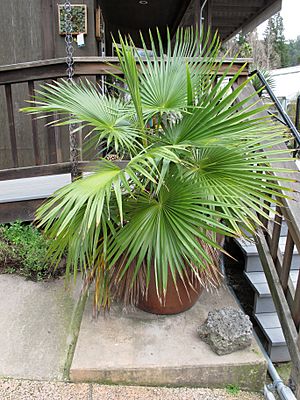Brahea calcarea facts for kids
Brahea calcarea is a type of palm tree. You can find it growing in Guatemala and Mexico. Sadly, this beautiful palm is currently in danger because its natural home is shrinking. This is often due to people cutting down forests or changing the land for other uses.
Quick facts for kids Brahea calcarea |
|
|---|---|
 |
|
| Conservation status | |
| Scientific classification | |
| Genus: |
Brahea
|
| Species: |
calcarea
|
| Synonyms | |
|
|
Contents
What is Brahea calcarea?
Brahea calcarea is a medium-sized palm tree. It is known for its strong trunk and large, fan-shaped leaves. These leaves can be a beautiful blue-green color. The tree also produces small, round fruits. These fruits are often eaten by local wildlife.
Where Does This Palm Grow?
This palm tree prefers to grow in rocky areas. It is often found on limestone hills. This is where it gets part of its name, "calcarea," which means "chalky" or "limy." It thrives in dry, sunny places. You can find it in forests and woodlands in parts of Mexico and Guatemala.
Climate and Habitat
Brahea calcarea is well-suited to warm climates. It can handle periods of drought. This makes it a tough plant in its natural environment. Its roots help it cling to rocky slopes. This allows it to grow where other plants might struggle.
Why is Brahea calcarea Important?
Every plant plays a role in its ecosystem. Brahea calcarea is no different. It provides food and shelter for many animals. Its strong roots can also help prevent soil erosion. This is especially true on steep hillsides.
Role in the Ecosystem
The fruits of the Brahea calcarea are a food source. Many birds and small mammals eat them. The palm's leaves offer shade and protection. This can be important for smaller plants and animals living nearby.
Uses by People
Local communities have sometimes used parts of this palm. The leaves can be used for thatching roofs. They can also be woven into baskets or hats. However, these uses are usually small-scale. They do not typically harm the palm's population.
What Threats Does It Face?
The biggest threat to Brahea calcarea is habitat loss. This means its natural home is being destroyed. People are clearing land for farming. They are also building new homes and roads. This takes away the space where the palm can grow.
Deforestation and Land Use Change
Forests where Brahea calcarea lives are being cut down. This is often for agriculture or cattle ranching. When the trees are removed, the palm loses its habitat. It also loses the other plants and animals it relies on.
Other Challenges
Sometimes, young Brahea calcarea palms are collected from the wild. People might want to plant them in gardens. While this might seem harmless, it can reduce the number of young palms. This makes it harder for the population to grow.
How Can We Help Protect It?
Protecting Brahea calcarea means protecting its habitat. This involves creating protected areas. It also means educating people about the palm's importance.
Conservation Efforts
Conservation groups are working to save this palm. They are trying to protect the forests where it grows. They also encourage sustainable land use. This means using the land in a way that does not harm the environment.
What You Can Do
You can help by learning more about endangered plants. You can also support organizations that work to protect them. Spreading awareness about Brahea calcarea and its habitat is also helpful. Every little bit helps to protect our planet's amazing plants.
See also
 In Spanish: Brahea calcarea para niños
In Spanish: Brahea calcarea para niños


